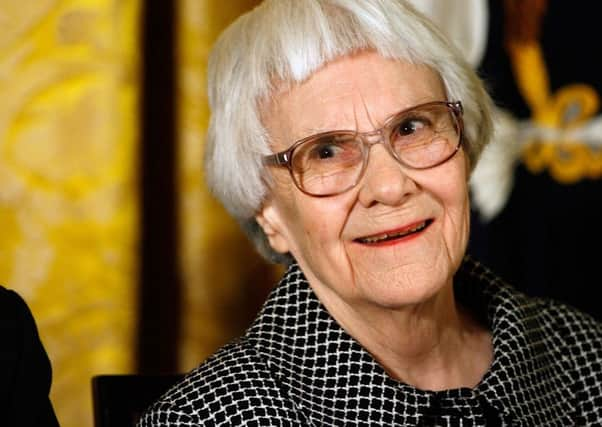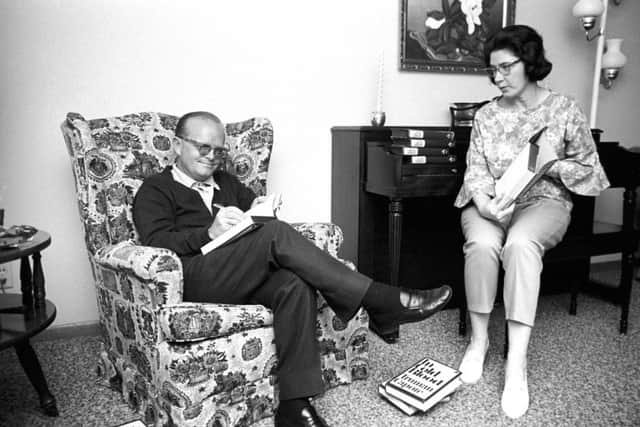Partners in crime: Truman Capote and Harper Lee


IN 2008, I wrote to Harper Lee requesting an interview. I knew I wouldn’t be able to persuade her to talk about writing To Kill A Mockingbird – in 40 years, nobody had. Instead, I wanted to find how she’d helped her childhood friend, Truman Capote, research In Cold Blood; maybe, I thought, if she was asked about someone else she would be less reticent.
She was polite, but firm. After a few pleasantries, she got to the crux of the matter. “I do not talk about Truman Capote to anybody,” she wrote.
Ah well. Nothing ventured and all that.


Advertisement
Hide AdBut I was disappointed. In Cold Blood – about the 1959 murder of Kansas farmer Herb Clutter, his wife Bonnie and their two teenage children – is not only a brilliant piece of reportage, but holds a fascination even beyond that. How many other non-fiction stories do you know on which two massively famous writers – both friends for a quarter of a century – worked together? And how many have been turned into not just one, but three rather good Hollywood films?
Although Harper Lee isn’t mentioned in the text of In Cold Blood, the Oscar-winning film Capote (2005) and Infamous (2006) both make plain the extent of her involvement. As the New Yorker film critic, Anthony Lane, pointed out, both films “left me absolutely convinced that it was Lee, not Capote who was the pivot and enigma of the whole improbable episode”.
I’d go even further. I find it hard to imagine how he could have written the book without her.
In November 1959, Lee agreed to accompany Capote to west Kansas as what he called his “assistant researchist” for a New Yorker feature on the Clutter killings. She was in New York at the time, awaiting publication of To Kill A Mockingbird, but otherwise free to travel with him to the town of Holcomb (population 270). As the murderers hadn’t yet been caught, the parameters of the story were clear enough: what’s the effect of such a horrific crime on a small town? Do people stop trusting each other? Do they become afraid? Above all, who on earth would want to kill an entire family, especially one as well-liked as the Clutters – for the sake of $40, a radio and a pair of binoculars?
At the time, Lee was 33 and Capote 35. They’d been friends since he was six, when his promiscuous, alcoholic mother, Lillie Mae, sent him off to live with relatives in Alabama Avenue, Monroeville. Lee lived next door. When they grew up, they wrote each other into their first novels. In Capote’s Other Voices, Other Rooms (1948) the tomboy, Idabel Thompkins, is modelled on Lee. In To Kill A Mockingbird, the child nicknamed Dill is based on Capote. “I’m Charles Baker Harris,” is how he introduces himself to Scout (the fictionalised Lee). “I can read.” So he could, and when he was picked on at school for being a bookish sissy, she defended him. In Lee’s novel it’s Dill who challenges Scout and her brother Jem to “make Boo Radley [their reclusive neighbour] come out”. “Even when he was an adult,” notes Ralph Voss in Truman Capote And The Legacy Of In Cold Blood, “Capote was to remain childlike in his imaginative vision, always alert, especially in his darker fiction, to catch a glimpse of the bogeyman.”
To Kill A Mockingbird has plenty of hints of the intensity of the friendship between Scout and Dill (one day, he promised her, they’d get married). Yet when it came to going to Kansas all those years later to investigate the Clutter killings, she wasn’t his first choice. That was a gay friend called Andrew Lyndon, another southerner living in New York.
Advertisement
Hide AdLyndon was busy, so Lee took his place. And it isn’t just the films that show how she persuaded the reluctant inhabitants of Holcomb to open up to the two strangers about the horrendous murders in their small town. They admit it themselves.
Take Bobby Rupp. Apart from the murderers, he was the last person to see the Clutters alive. He was 16 at the time and “going steady” with their murdered daughter, Nancy. Interviewed 50 years after the murders, he said: “The type of person Capote was threw me off right away. He wasn’t the kind of person I wanted to spend time with – he was very, very strange.” Lee was different, altogether more normal. And she was the one, he noted, who asked most of the questions – “so much that sometimes I wonder who really wrote that book”.
Advertisement
Hide AdHarold Nye, the detective who found the murderer’s shotgun, disliked Capote on sight, and his account of their first meeting drips with homophobia. “Here he is in a kind of new pink negligee, silk with lace, and he’s strutting across the floor with his hands on his hips telling us how he’s going to write this book… Harper Lee was there. Absolutely fantastic lady. I really liked her very much. But I didn’t get a very good impression of that little son of a bitch.”
These days, we might admire the uncompromising way in which Capote refused to pretend that he was anything other than a camp, effeminate man. But in the pre-Stonewall Midwest, a boa-wearing man in a pill-box hat with an amazingly high-pitched voice (“Imagine how a Brussels sprout would sound if a Brussels sprout could talk,” said Gore Vidal) was an off-putting oddity. “Those people had never seen anything like Truman,” Lee once said. “He was like someone coming off the moon.”
When I went to west Kansas myself eight years ago, the people I met who had known Lee (Nelle to her friends) remembered her fondly. To Duane West, who prosecuted the killers, she was “a fascinating person”, whereas Capote was “a kook”. And to Dolores Hope, a columnist on the Garden City Telegram, whose late husband Clifford was the Clutters’ lawyer and who had given them permission to look around the murder scene, she was a necessary corrective to Capote’s flamboyance.
“She was like a big sister to him,” Hope told me. “She knew how to keep him happy. She had no airs or graces about her – she was real natural. She’d come across to help me in the kitchen and we’d get to talking, and it was as if I’d always known her.” A friendship began that still continues, just one sign of it the first edition copy of To Kill A Mockingbird she shows me, signed “To Dodie, with love and affection, Nelle”.
Capote and Lee first visited the Hopes on Christmas Day, 1959. Although they’d been staying in a motel in Garden City, they hadn’t met many of the locals. But the visit was a success: Capote spinning tales of Hollywood, name-dropping furiously while tucking into the goose Dolores had cooked, Lee rolling her eyes indulgently at his celebrity gossip. Word got around. Doors started to open. “At first it was hard,” Capote wrote to a friend, “but now I’m practically mayor!” Alvin Dewey, lead detective on the case, was another new friend: a couple of weeks later, Capote and Lee were at his house when news came through that the Clutters’ killers had been arrested.
Capote was now on the inside track. Dewey, against the letter of the law, gave him Nancy Clutter’s teenage diary to read, and told him in detail how the killers had been caught. True, Capote would still have to talk to them, and maybe if he could persuade one of then to open up, he might have a book on his hands. Maybe even a classic. But without Lee to start him off with his Kansas interviews, I wonder whether he’d have had anything at all. n
Twitter: @scotsmandavid
• David Robinson will be talking about In Cold Blood at the Edinburgh International Book Festival on 26 August. Harper Lee’s new book, Go Set A Watchman, is published by William Heinemann on Tuesday